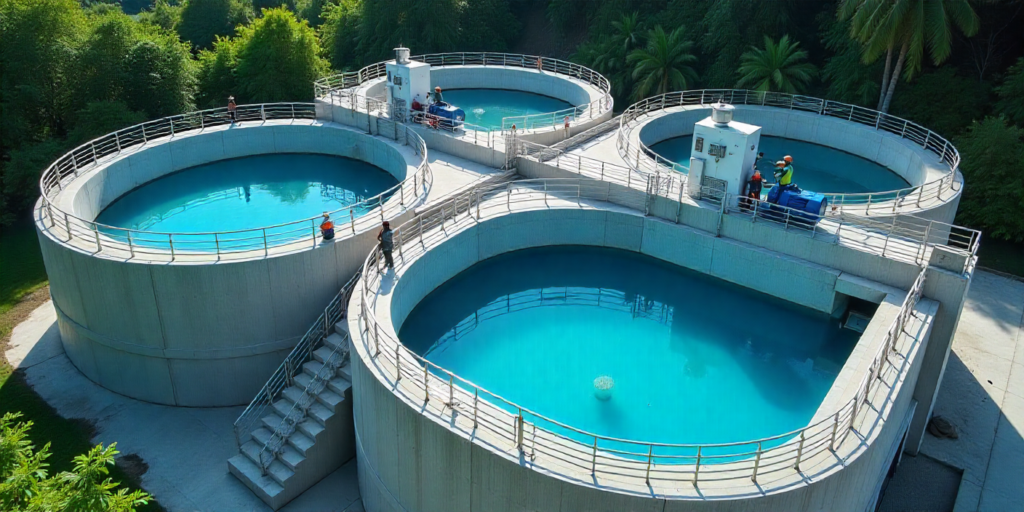Every day, tons of wastewater flow out of factories, homes, and commercial buildings. If left untreated, it can pollute rivers, damage ecosystems, and even affect our health. That’s where a wastewater treatment plant comes in — it cleans and recycles used water, making it safe for reuse or discharge.
In this blog, we’ll explore how a wastewater treatment plant works, why it’s important, and how companies like Genviss are helping industries across India turn wastewater into a reusable resource.
What Is a Wastewater Treatment Plant?
A wastewater treatment plant (WWTP) is a facility designed to remove impurities, chemicals, and harmful microorganisms from wastewater. It’s a vital part of modern infrastructure — whether in industrial zones, housing projects, or city systems.
Simply put, the plant treats dirty water through physical, chemical, and biological processes until it meets quality standards for reuse or safe disposal.
There are different types of treatment plants based on their purpose:
- ETP (Effluent Treatment Plant) – for industrial wastewater
- STP (Sewage Treatment Plant) – for domestic or municipal wastewater
- ZLD Systems (Zero Liquid Discharge) – for complete water recovery with no discharge
Why Wastewater Treatment Is Important
Treating wastewater isn’t just about compliance — it’s about sustainability and responsibility.
- Environmental protection: Prevents harmful discharge into water bodies
- Regulatory compliance: Meets CPCB / GPCB standards in India
- Water conservation: Enables industries to recycle water and reduce dependency on fresh sources
- Cost savings: Reusing treated water lowers water procurement costs
UN Sustainable Development Goal on Clean Water → here
World Health Organization safe-water guidelines → here
Did you know?
Treating just 1,000 liters of wastewater can save nearly 800 liters of fresh water for reuse — a huge step toward water sustainability.
Step-by-Step Process of Wastewater Treatment
Let’s look at how the process actually works — from the moment wastewater enters the plant until it comes out clean and reusable.
1. Preliminary Treatment
This is the first stage where large solids and debris like plastics, rags, or stones are removed using screens and grit chambers.
It protects downstream equipment and ensures smooth operation.
2. Primary Treatment
Here, the wastewater is allowed to sit in sedimentation tanks so that heavier particles settle at the bottom while lighter materials like oil float on top.
The settled material (sludge) is removed, and the partially treated water moves ahead.
3. Secondary Treatment (Biological Process)
This stage removes dissolved and organic impurities using microorganisms.
The most common process is the Activated Sludge Process (ASP), where air is pumped into aeration tanks to encourage microbial growth that breaks down organic matter.
By the end of this stage, most impurities are gone.
4. Tertiary Treatment
To achieve even higher purity, the water passes through filters (like sand, carbon, or membrane filters) and then gets disinfected using UV light or chlorine.
This ensures the water is safe for reuse in industrial or non-potable applications.
5. Sludge Treatment and Disposal
The sludge collected from earlier stages is thickened, dewatered, and treated.
It can be used as compost, biogas fuel, or disposed of safely depending on composition.
Applications of Wastewater Treatment Plants
Wastewater treatment plants are essential across many sectors, such as:
- Textile and Dyeing Industries – Removes dyes, chemicals, and organic waste
- Pharmaceuticals – Treats chemical-heavy effluents
- Food & Beverage – Manages organic waste and oils
- Chemical & Metal Industries – Handles toxic compounds safely
- Housing Societies and Real Estate – Recycles domestic sewage for landscaping or flushing
Each industry needs a customized treatment solution, and that’s where expert design and engineering come in.
The Role of Genviss in Wastewater Treatment
At Genviss, we specialize in designing, installing, and maintaining wastewater treatment systems tailored for different industries.
From compact STPs for residential complexes to large-scale ETPs for chemical plants — our solutions ensure regulatory compliance, energy efficiency, and sustainability.
Why choose Genviss?
- Customized plant design as per CPCB/GPCB standards
- Energy-efficient and low-maintenance systems
- Advanced monitoring and automation
- End-to-end support from design to AMC (Annual Maintenance Contract)
Our mission is simple — to help industries reuse every drop they can and make wastewater management truly sustainable.
Conclusion
Wastewater treatment is not just a regulatory requirement — it’s a vital step toward a cleaner, greener, and more resource-efficient future.
A properly designed wastewater treatment plant not only protects the environment but also saves industries money in the long run.
If you’re planning to install, upgrade, or maintain a wastewater treatment system, Genviss is here to help you every step of the way.
Contact Genviss today for expert consultation, cost estimation, and sustainable water management solutions.

